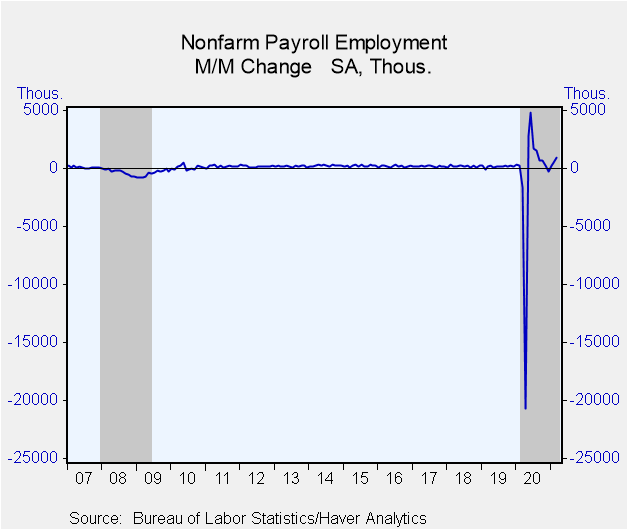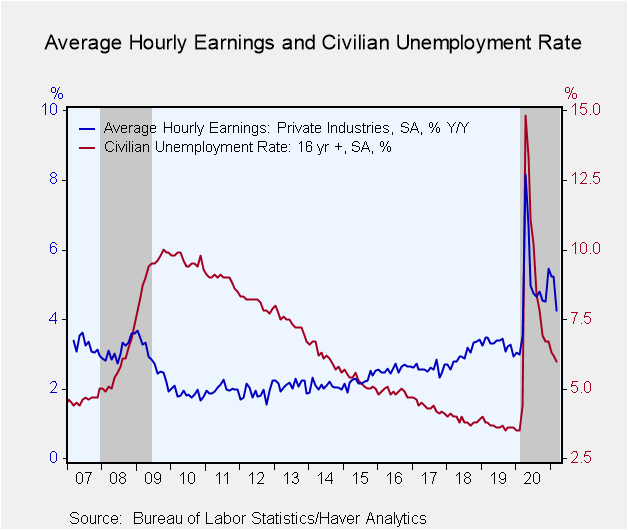 Global| Apr 02 2021
Global| Apr 02 2021U.S. Payrolls are Unexpectedly Strong During March; Unemployment Rate Declines
by:Tom Moeller
|in:Economy in Brief
Summary
• Leisure & hospitality plus construction drive jobs strength. • Average hourly earnings slip. • Unemployment rate declines to lowest level in twelve months. The labor market has revived with business re-openings following [...]
• Leisure & hospitality plus construction drive jobs strength.
• Average hourly earnings slip.
• Unemployment rate declines to lowest level in twelve months.
The labor market has revived with business re-openings following restrictions due to COVID-19. Nonfarm payroll employment strengthened 916,000 (-4.4% y/y) in March after rising 468,000 during February, revised from 379,000. The January gain of 233,000 also was revised higher from 166,000. A 613,000 increase in March had been expected in the Action Economic Forecast Survey. The forecast estimates of the March payroll change ranged from 280,000 to 961,000 amongst 26 forecasters.
Average hourly earnings eased 0.1% (+4.2% y/y) last month compared to a 0.3% February rise, revised from 0.2%. February earnings rose 0.3%, revised from 0.2%, A 0.1% gain in March had been expected.
The unemployment rate declined to an expected 6.0% from 6.2% in February. Employment in the household survey rose 609,000 (-3.0% y/y) after increasing 208,000 in February while the labor force strengthened 347,000 (-1.3% y/y) after gaining 50,000 in February. The overall jobless rate, including those who were marginally attached or working part-time for economic reasons, fell to 10.7% from 11.1% and was below the 22.9% high reached in April of last year.
The employment & earnings data are collected from surveys taken each month during the week containing the 12th of the month. The labor market data are contained in Haver's USECON database. Detailed figures are in the EMPL and LABOR databases. The expectations figures are in the AS1REPNA database.
| Employment (SA, M/M Change, 000s) | Mar | Feb | Jan | Mar Y/Y | 2020 | 2019 | 2018 |
|---|---|---|---|---|---|---|---|
| Payroll Employment | 916 | 468 | 233 | -4.4% | -5.8% | 1.3% | 1.6% |
| Previous Estimate | -- | 379 | 166 | -- | -- | -- | -- |
| Manufacturing | 53 | 18 | -18 | -3.3 | -5.0 | 1.0 | 2.0 |
| Construction | 110 | -56 | 12 | -1.1 | -3.0 | 2.8 | 4.6 |
| Private Service-Producing | 597 | 602 | 129 | -4.6 | -6.6 | 1.4 | 1.5 |
| Government | 136 | -90 | 111 | -5.0 | -3.1 | 0.7 | 0.5 |
| Average Weekly Hours - Private Sector | 34.9 | 34.6 | 35.0 | 34.1 | 34.6 | 34.4 | 34.5 |
| Private Sector Average Hourly Earnings (%) | -0.1 | 0.3 | 0.0 | 4.2 | 4.8 | 3.3 | 3.0 |
| Unemployment Rate (%) | 6.0 | 6.2 | 6.3 | 4.4 | 8.1 | 3.7 | 3.9 |
Tom Moeller
AuthorMore in Author Profile »Prior to joining Haver Analytics in 2000, Mr. Moeller worked as the Economist at Chancellor Capital Management from 1985 to 1999. There, he developed comprehensive economic forecasts and interpreted economic data for equity and fixed income portfolio managers. Also at Chancellor, Mr. Moeller worked as an equity analyst and was responsible for researching and rating companies in the economically sensitive automobile and housing industries for investment in Chancellor’s equity portfolio. Prior to joining Chancellor, Mr. Moeller was an Economist at Citibank from 1979 to 1984. He also analyzed pricing behavior in the metals industry for the Council on Wage and Price Stability in Washington, D.C. In 1999, Mr. Moeller received the award for most accurate forecast from the Forecasters' Club of New York. From 1990 to 1992 he was President of the New York Association for Business Economists. Mr. Moeller earned an M.B.A. in Finance from Fordham University, where he graduated in 1987. He holds a Bachelor of Arts in Economics from George Washington University.








